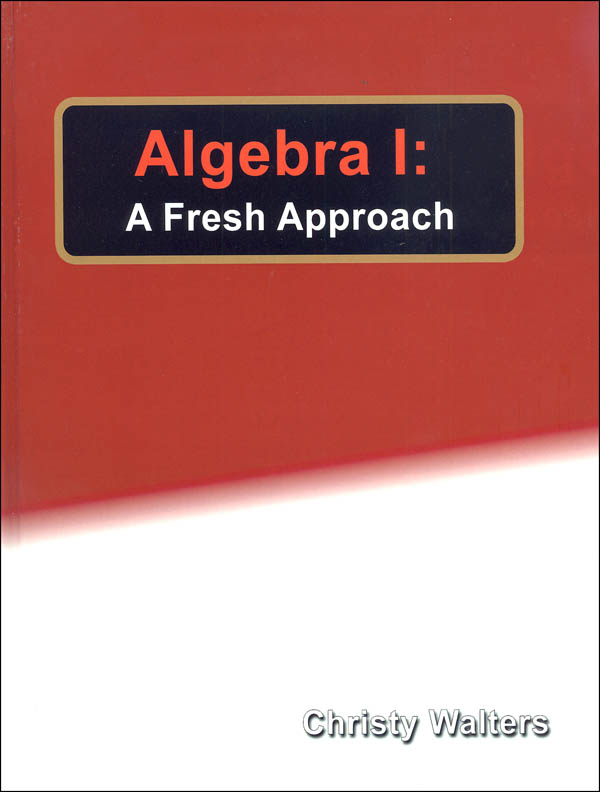If you are looking for a different
approach to Algebra with:
- Logically organized introduction
of concepts
- Simple, clear explanations
- Student-directed instruction
- Non-intimidating text
- Workspace in the text (or to
photocopy and work)
- Thorough coverage of algebraic
concepts without "extras" thrown in
- A discovery approach to learning
Then these texts may be just what
you're looking for. The author has made clear choices to keep the course
simple, understandable, self-directed, and easy to navigate. Even the font
sends a "you can do it" message. It's large, bold, crisp, and clear
with plenty of white space on each page. There are no side notes or rabbit trails
here; everything is direct, on task, and pertinent to mastering Algebra. The
result of this is a less overwhelming feel to the text. This approach would
work well both for the student who is an independent learner and the student
who doesn't particularly enjoy math (the "let's just get it done"
type). Some children don't really care for the (exciting to me!) explanations
and nuances of mathematics. They just need to learn it to get to college or go
on to what they're really interested in. They need it like a tool to use; not
like a painting to be studied and enjoyed. These are the children that will
appreciate what Christy Walters (author) has done in this curriculum. Her
no-nonsense, straightforward explanations and examples will help both types of
student focus on understanding how Algebra works and overcoming any
reservations they may have about their ability to conquer the subject.
I appreciate that she has also
incorporated self-discovery here; when a student makes their own connections,
they understand and retain them. For example, she doesn't introduce the
difference between two squares factoring method as a different way of
factoring. She purposely made the decision to allow students to discover this
unique relationship for themselves. The way she introduces factoring gives them
the understanding and confidence they need to just tackle this unique problem
like any other factorization problem. While there are techniques you can apply,
many students do better if they intuit those independently through trial and
error. This is especially true of children who don't do well remembering a
bunch of rules and techniques. They are forever "lost" applying
random techniques to a problem in an effort to find the "right" one,
but without a clear sense of which one to apply! If I sound like a parent of a
math-indifferent child, well, let's just say they're not all "chips off
the old block"!
Mrs. Walters has, indeed, managed to
keep it simple rather than mysterious, bewildering, and perplexing! It would be
difficult for a child to be confused by the direct and understandable
instruction. Moreover, she takes learners through examples step-by-step and
supplies many practice problems that grow gradually more complex. She
concentrates on one skill at a time in progression from simple to complex. Her
approach is stranded rather than spiral. Chapters are organized topically with
a mixed review at the end of each. You will not revisit mastered concepts
unless they are needed to solve more complex problems later. If you allow your
child to "use" the text, they can write in it; she has left ample
space to do so. Otherwise, you could photocopy the problem set pages and put
them in a notebook. There are also note pages at the end of each chapter so the
student can keep summary thoughts or points to remember together. Answers to
odd-numbered problems are in the back of the text. Answers to all even problems
(showing all solution steps) are contained in the solution guides. There is no
separate teacher book or manual needed; the text contains all needed
instruction. There are also no separate test books and keys. The Mixed Review
problems at the end of each chapter are to be used for testing the
understanding of all material in that chapter. The author has left her email
address in the preface and welcomes all comments and/or suggestions. Algebra
I was revised in 2016 and features some reorganization of topics and
some new sections including statistics, probability, scientific notation,
graphing exponential equations, rates of change, operations with sets and
parent graphs. (Old and new version components are not compatible.)
The perfect component to round out
this program is a complete set of tests, Algebra 1 Test Packet
(045971). There is one test provided per chapter, and the tests vary from 2 to
4 pages in length. Tests in this packet correspond directly to chapter content,
and beginning with chapter six they include a section of review problems on
each test. Tests are printed on 8 ½ x 11-inch paper with plenty of space for
students to show their work. The tests are not 3-hole punched, so the first
thing I would do is punch them and put them in a binder. Complete solution
keys for all tests are included in this test packet.
This course is, indeed, a
"fresh" approach. There is no "one size fits all" math
curriculum, so if your child is having trouble with other traditional
approaches, you might want to try this one on. Unlike some other programs out
there, this one is comprehensive in coverage, not "dumbed down".
While the methods are fresh, the course is serious in scope and is college
preparatory. If you compare course content to Saxon, you will notice that it
does not include topics that are normally taught in Geometry (or other branches
of math – like box and whisker plots which are normally taught in Statistics).
Read on for more details on the Geometry program!


